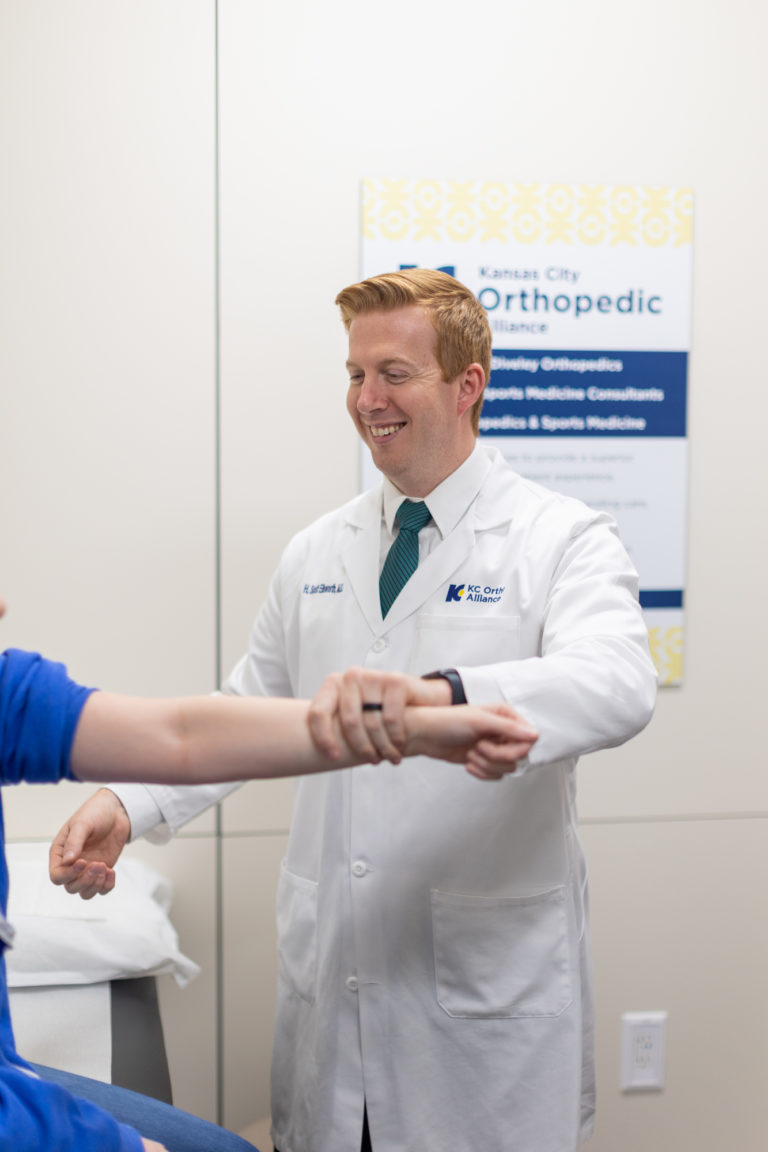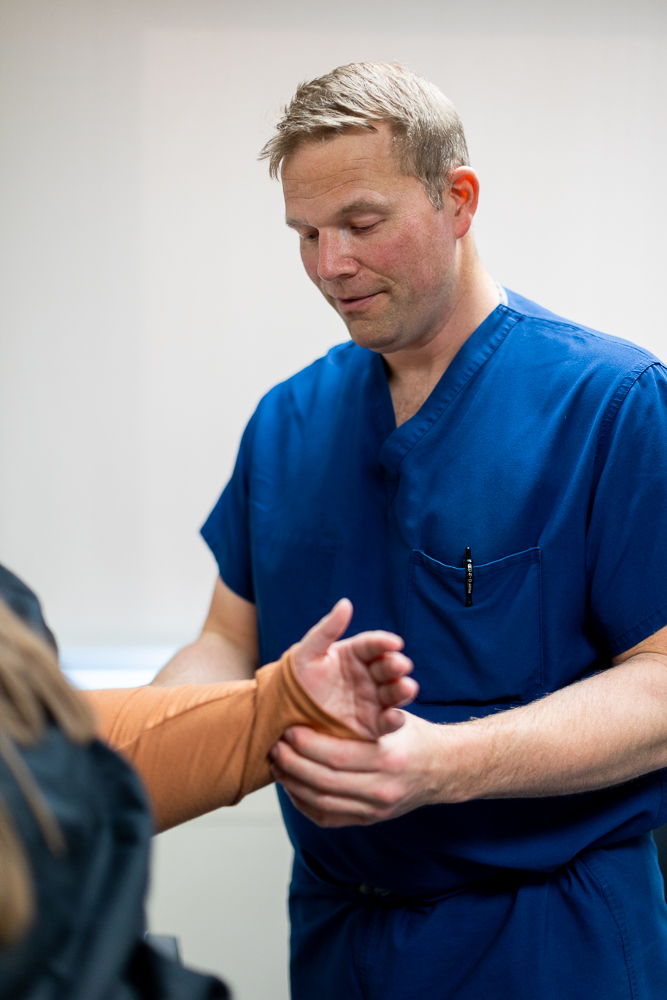Tommy John Surgery in Kansas City
Tommy John Surgery
Long-term solutions to get you back in the game.

Understanding the Basics Behind Tommy John Surgery
What is Tommy John Surgery?
Baseball fans have likely heard about Tommy John surgery.
This is a common treatment for repairing a torn ulnar collateral ligament (UCL) in the elbow, an injury that plagues pitchers at all levels. But injuries to the UCL happen off the diamond, too.
Sports injuries, like UCL tears, are commonplace in today’s active world. Athletes of any kind can succumb to an elbow injury, especially in sports that involve heavy lifting or repetitive throwing. Tommy John surgery in Kansas City is an option for treating UCL tears in active people of all kinds.
After your initial examination with a KCOA physician, we will recommend the best treatment for your needs. Our practitioners provide the comprehensive care you need so you can return to the activities you enjoy.
Choosing Tommy John surgery in Kansas City is a decision that typically involves guidance from your primary care doctor and orthopedic physician.
When you choose Kansas City Orthopedic Alliance, one of our highly-trained orthopedic elbow specialists will conduct an initial evaluation to better understand your condition. After a complete review of your results, your provider will then discuss whether Tommy John surgery is the best treatment option for you.
Other indications that someone may need Tommy John treatment include:
- Reduced range of motion
- Swelling
- Weakness
- Stiffness
- Completely immobile or “locked” joint

Kansas City Orthopedic Alliance Elbow Injuries Assessment
Assessing the Injury
Finding the right elbow treatment in Kansas City starts with an assessment.
You can think of elbow pain as a spectrum, with some instances being more severe than others. The KCOA orthopedic specialists always focus on each individual patient and their concerns before creating a treatment plan. Therefore, during your initial appointment, we will often ask questions such as:
Therefore, during your initial appointment, we will often ask questions such as:
The answers to these questions help shape the next steps of the assessment process and guide our physical examination. After a proper assessment, we often begin with a physical examination to help determine the origin point of your pain. In some cases, advanced testing may be required for a full diagnosis.
- Does your pain currently limit you or your activities?
- Has your pain progressed or worsened recently?
- Have you experienced any tingling or numbness in your arm or fingers that makes tasks difficult?
- Did you notice or hear a popping sound at the time of your injury?
- Have you noticed any change in your symptoms that has made it more challenging to function?
- What are your lifestyle goals?
- How has pain affected those goals?
Examination
X-Ray
Also called radiographs, an X-ray captures a picture of the elbow. Orthopedic physicians may order an X-ray to rule out the possibility of a fracture (broken bone), osteoarthritis, or other elbow-related conditions.
Magnetic Resonance Imaging (MRI)
MRI captures images of muscles, bones, and tendons to help provide information other tests can’t detail. During an MRI, you will lie on a table that slides into a tube-shaped scanner. The machine creates a magnetic field around you, using pulsed radio waves to form the MRI images of the body parts being examined. Injecting a specific dye into the joint prior to the MRI may provide improved visualization of a suspected UCL injury.
Symptoms
Common Signs and Symptoms of Elbow Injuries
With so many different parts working together in your elbow, there are many potential causes of elbow pain. And each of those causes has a unique set of symptoms.
UCL injuries often cause pain on the inside of your elbow. Patients may report hearing a “popping sound” or experience sharp pain during an acute injury. Injuries to the UCL can come from acute trauma after a fall from a height or if the joint bends the wrong way, but the most common cause of UCL damage is gradual stretching of the ligament over time from repeated significant forces across the elbow joint. Elite baseball pitchers typically suffer from this kind of joint stress, but other repetitive movements in activities like weight lifting can also cause UCL damage.
what causes elbow injuries?
Anatomy of the Elbow
The body has different kinds of joints, and they all face different challenges. The elbow is a complex joint that connects 3 different bones: the humerus (upper arm), ulna (pinky side forearm), and radius (thumb side forearm). Covering the surface where these bones meet is articular cartilage, a smooth substance that protects the joint by cushioning and absorbing forces.
On the inside and outside of this joint are ligaments that hold the elbow together and prevent dislocation. One of these ligaments is the UCL, a small ligament on the inner portion of the elbow that provides stability for the elbow joint.
Treatment Alternatives
Surgery, even when minimally invasive like elbow arthroscopy, isn’t necessarily the first choice. Kansas City Orthopedic Alliance physicians prefer a more conservative approach to treatment, so we will typically exhaust all non-surgical options before recommending surgery. Non-surgical treatments for shoulder injuries include:
Physical Therapy
Movement can actually reduce pain and encourage healing in the elbow, as movement increases circulation in the joint, supplying oxygen and other nutrients that support joint health and function.
Medications
Your doctor may recommend over-the-counter NSAIDs (Non-steroidal anti-inflammatory drugs, such as Advil) or prescription medications. Especially with NSAIDs, you should always talk to your doctor to ensure they are the right treatment for you.
Injections
Cortisone injections can help reduce inflammation, and the effects tend to last for 3 to 6 months before you might need another one. Many people manage their pain with injections and physical therapy.
Regenerative Medicines
Regenerative medicines like stem cell injections or platelet-rich plasma can help nourish worn or damaged tissue. This option works best if you have mild-to-moderate elbow pain.
F.A.Q.
Frequently Asked Questions
Kansas City Orthopedic Alliance can get you back in the game.
Our care is personal. Our team is knowledgeable. And we’re more available than ever.
With access to board-certified specialists across Kansas City, we have the tools to meet almost every musculoskeletal condition.
Our Locations
Overland Park, Kansas
10777 Nall Ave Suite 300 Overland Park, KS 66211Leawood, Kansas
3651 College Blvd. Leawood, KS 66211Kansas City, Missouri
Saint Luke's Medical Plaza #1 4320 Wornall Rd., Ste. 610 Kansas City, MO 64111Belton, Missouri
Belton Regional Campus 17067 S Outer Rd #301 Belton, MO 64012Blue Springs, Missouri
St. Mary’s Medical Center, Main Entrance 203 NW R.D. Mize Road, Suite 200 Blue Springs, MO 64014Shawnee Mission, Kansas
7450 Kessler St ste. 140 Merriam, KS 66204Prairie Star (Lenexa, Kansas)
Prairie Star 23401 Prairie Star PkwyBldg. B, Ste. 220 Lenexa, KS 66227








